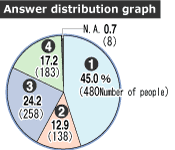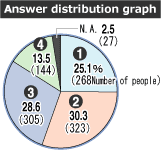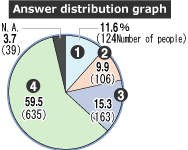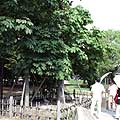Hiroshima Quiz - 1,067 people responded

We featured our "Hiroshima Quiz" in issue 33 of Peace Seeds. The quiz consisted of twenty questions relating to the dropping of the atomic bomb. Altogether, we received 1,067 responses from Hiroshima residents and non-residents alike. At some junior high schools in Hiroshima and on Etajima Island, and at a high school in Osaka, the quiz was done as a class activity.
Here are the correct answers to the quiz, together with the average scores and percentage of correct answers.
Click to read "Hiroshima Quiz"
笳・ 笳・/pre>
Fifty people, 4.7% of the total number of participants, got full marks in the quiz. The average number of correct answers was12.8 out of 20, for an average score of 64 points (out of 100).
Question 2 received the highest percentage of correct answers. The First three questions were about basic knowledge, such as the date of the atomic bombing, so more than 90% of the responses were correct.
However, questions 8 and 18, which were about the number of atomic bomb victims and survivors, proved to be more difficult and not quite half of the quiz-takers got the answers right. Most people who got those questions wrong chose estimated figures for the dead and the survivors that were too low.
Question 5 was about the radioactive material that was used in the Hiroshima-type atomic bomb. Many people confused it with the atomic bomb that was dropped on Nagasaki. Most of the people who got question 12 wrong thought the answer was (1), war. In both cases, perhaps people had the feeling that they vaguely knew the answers, but they became perplexed when confronted with definite choices.
The question which fewest people answered correctly was question 7. 799 people, or three quarters of the quiz-takers, chose the wrong answer.
Questions and answers(Red is the correct answer)
Please choose only one answer from the four choices below each question. (Each question is worth 5 points and the time limit is 20 minutes.)
Question 1: In what year was the world's first atomic bomb dropped on Hiroshima?
(1) 1920 (2) 1930 (3) 1945 (4) 1965
Question 2: The atomic bomb was dropped on a Monday at a time when many people were on their way to work or school in the city center. What was the date and time?
(1) 7:30 a.m. on August 2 (2) 8:15 a.m. on August 6 (3) 11:02 a.m. on August 9
(4) 10:15 a.m. on August 15
Question 3: Which country dropped the atomic bomb?
(1) North Korea (2) USSR (3) the United States (4) Germany
Question 4: Which landmark was the target of the atomic bomb?
(1) Aioi Bridge (2) Hiroshima Castle (3) Peace Bridge (4) Shima Hospital
Question 5: Unlike other weapons, the atomic bomb contained radioactive material which has caused survivors to suffer from cancer and leukemia. What is the radioactive material that was used in the Hiroshima-type atomic bomb?
(1) Uranium (2) Plutonium (3) Hassium (4) Aluminum

Question 6: There is an inscription on the Cenotaph for the A-bomb Victims, located in Peace Memorial Park, which is a prayer for the repose of the victims and an end to war. Which of the following four lines is the actual inscription?
(1) This is our cry. This is our prayer. For building peace in this world.
(2) Give back my father, Give back my mother, Give back peace, That will never end.
(3) Let all the souls here rest in peace; For we shall not repeat the evil.
(4) May the tragedy of Hiroshima become the foundation of world peace.
Question 7: Who created the text for this inscription?
(1) Tadayoshi Saika, Professor of Hiroshima University
(2) Sankichi Toge, Poet
(3) Shinzo Hamai, Mayor of Hiroshima
(4) Kenzo Tange, Assistant Professor of Tokyo University
Question 8: Every year, the Hiroshima city government adds the names of the dead to the register of the names of those who died as a result of the A-bomb, which is placed in the Cenotaph. As of August 6, 2007, about how many names are included in this registry?
(1) 10,000 (2) 50,000 (3) 150,000 (4) 250,000
Question 9: The A-bomb Dome was a building that was visited by many people before the war. What was it?
(1) a bank (2) a cinema (3) a department store (4) a special product exhibition hall
Question 10: Why has the A-bomb Dome been preserved?
(1) Because the citizens of Hiroshima wanted to convey the devastation of the atomic bomb.
(2) Because people wanted to register it as a World Heritage site.
(3) Because the United States bought the building as a token of regret.
(4) Because it cost too much to demolish it.

Question 11: Before it was bombed, the site of the present Peace Memorial Park was a place where people gathered. What kind of location was it?
(1) a business street with many office buildings, including City Hall
(2) a shopping mall
(3) a park
(4) a downtown area with restaurants and shops
Question 12: The Flame of Peace in Peace Memorial Park was lit in 1964 and it will burn until the day something disappears from the earth. What is that "something"?
(1) War (2) Guns (3) Violence (4) Nuclear weapons
Question 13: Some monuments in and around Peace Memorial Park are dedicated to schools and schoolchildren. Why?
(1) Because there were many schools nearby.
(2) Because many schools in the city were destroyed by the atomic bomb.
(3) Because each school eagerly engaged in peace studies.
(4) Because many students were killed by the atomic bomb while dismantling buildings to create firebreaks.
Question 14: Sadako Sasaki, the girl who inspired the Children's Peace Monument, made paper cranes while in the hospital with leukemia. Why did she make paper cranes?

(1) Because it was her hobby.
(2)Because she believed that if she folded a thousand cranes, she would recover from her illness.
(3) Because cranes are symbols of peace.
(4) In order to exercise her fingers.
Question 15: Most buildings near the hypocenter were destroyed and burned by the blast and heat, but a few buildings remain even today. Which of these is NOT a bombed building?
(1) The Rest House in Peace Memorial Park
(2) The Hiroshima branch of the former Bank of Japan
(3) The main Fukuya Department Store (in Hatchobori)
(4) Hiroshima Municipal Baseball Stadium
Question 16: People who entered the city after the bombing developed similar symptoms to people who were exposed to the bomb blast, such as loss of hair and hemorrhaging without apparent wounds. Why?
(1) Because of stress.
(2) Because of an outbreak of infectious disease.
(3) Because of the effects of residual radiation.
(4) Because they didn't have enough food.
Question 17: The exact number of people who were killed by the atomic bomb is not clear. How many people are estimated to have died by the end of 1945, the year of the bombing?
(1) 6,000 (2) 40,000 (3) 140,000 (4) 1.2 million
Question 18: How many people possess an Atomic Bomb Survivors Certificate as of the end of March of 2007?
(1) 132 (2) 2,092 (3) 251,834 (4) 2,108,727
Question 19: The flower in the picture below is a Hiroshima city flower which was said to have been the first to bloom after the bombing. What is it?
(1) Paulownia (2) Rose (3) Oleander (4) Water Lily
Question 20: Which country DOES NOT currently possess nuclear weapons?
(1) Canada (2) the United States (3) the United Kingdom (4) China
Commentary

The correct answer is (1), Aioi Bridge, which is a T-shape bridge at the north end of Peace Memorial Park. A quarter of the respondents chose (3), Peace Bridge. That bridge is on Peace Boulevard and spans the Motoyasu River. It was built during the period of reconstruction after the atomic bombing. A sculptor of international standing, Isamu Noguchi, designed the bridge railing. The bridge was completed in 1952. 
The correct answer is (1), Tadayoshi Saika, a Hiroshima University professor who specialized in English literature. The mayor of Hiroshima at that time, Shinzo Hamai, asked him to write the text for the inscription. Two of the other choices, (2) Sankichi Toge and (3) Shinzo Hamai, were each picked by about 30% of the respondents.
Choice (3), Park, was selected by 31% of the quiz-takers. In fact, what is now Peace Park was formerly full of restaurants, bars, hotels, shops and so forth. The surface of the park rests on a 15-40 cm layer of earth, beneath which the debris of those buildings may be found. 
Hiroshima City has registered 90 buildings within a radius of 5 km of the hypocenter that survived the atomic bombing. How about visiting those buildings one day? Choice (4), Hiroshima Municipal Baseball Park, was built in 1957, 12 years after the bombing. 
Although 50.5% of the participants chose (4), Paulownia, the correct answer is (3), Oleander. Those who chose paulownia might have been thinking about the famous A-bombed paulownia (photo) in Peace Memorial Park. In a city-wide referendum that took place in 1973, the oleandar was chosen as the emblematic flower of Hiroshima City. Impressions Many people sent us some feedback with their answers. Not a few people wrote about their own experiences, or about family members they lost in the bombing. When we read through the responses, one in particular stood out. "There was a lot of stuff I didn't know, but from now on, gradually I want to find out more. One day, I'd like to teach future generations about it." This was from a sixth-grade student in Hiroshima City. Some adults were also inspired by this quiz. One quiz-taker expressed the feeling that, "We have more opportunities to study this material than people from other prefectures, so we ought to know more about it" (Mihara City, 27). We hope you will not stop now that you have completed the test, but will visit Peace Memorial Museum, read books, or surf the Internet to find answers to any items you do not understand or new questions that you may now have. |
